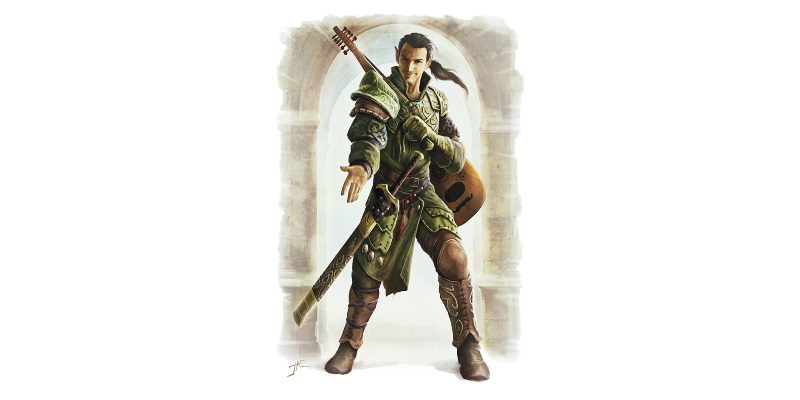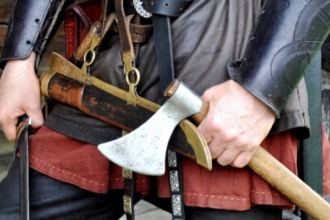The Bard Class, Part Five

The Bard Class, Part Five
At last, we come to Act V in the drama of the Bard. The narrative arc to date has been… more of a picaresque than anything, with movements in many conflicting directions, often contradicting earlier developments. In Act I (OD&D and 1e), we established the conflict: what the hell is this class? Is it a pseudo-wizard with reduced-but-potent casting progression and percentile skills? a proto-Prestige Class? In Act II (2e), we see that the class’s bread-and-butter is its deceptive potency, as a superficial weakness is bolstered by a massive advancement advantage that would be easy to miss. The third Act (3.x) attempts an initial resolution of the dialectic. It fails, with drama! The class has a place, but if all classes are equal, the bard is a little less equal than others. Act IV (4e) propounds a new theme, raising the stakes for Act V (5e). Yet ever as we listen, shall we come to a deeper understanding, and increase in unison and harmony?
Thematically, the Bard looks back to the 3.x Bard more than the 4e Bard. This is true of a lot of 5e classes, and (sorry, hardcore 4e fans) contributes to 5e’s runaway success in the marketplace. It’s a head fake, though: mechanically, this is a 4e Bard who found Daddy’s credit card and the keys to the Mercedes.
- d8 Hit Die and proficiency in any three skills. Interesting. I’m very happy that Bards and Rogues have caught up with clerics, monks, and druids in receiving the perfectly midrange d8 Hit Die. It feels like a lot more resilience than a d6, even if it does average to just one extra hit point per level. The point is, 5e Bards can enter melee without worrying quite as much that any hit will be their last, as compared to 3.x.
- The Bard spell list has lost a lot of flash and variety of damage types, though it has retained a solid position as a healer equal to any cleric outside the Life domain. This is by far the most important thing to carry over from 4e. I have to say that at first level, it costs the bard comparatively more to be a healer (because of limited spell knowledge). By second level, though, Song of Rest starts mitigating the Bard’s spells spent on healing, and that only gets better.
- I have to wonder how they decided the number of cantrips for each casting class. Bards, druids, and warlocks get two, clerics and wizards get three, and sorcerers get four. Three and four seem fine; two seems really stingy. This is part of a broader complaint about low-level characters having too few at-will options, though.
- Bardic Inspiration is several different 3.x-style Inspire features rolled into one, and expanded by your Bardic College choice at 3rd Inspirations are a currency for the Bard, and it’s interesting how the system throttles that currency: instead of handing out more, it changes how you refresh them. Apparently the system really doesn’t want you to have more than five at a time, but after 5th level, they’re fine with the Bard having five uses several times a day, as Inspirations start refreshing on short rests.
- Adding the word “Bardic” in front of “Inspiration” is not enough syntactical distinction between this ability and the Inspiration you get from Ideals, Bonds, and Flaws.
- Anyway, the bonus from Bardic Inspiration scales up as well, and it’s all handled as a bonus die rather than a flat add. I find bonus dice more interesting than flat adds in 5e, because they’re easier to remember (it helps to set the die out in front of you) and less predictable – they feel less like building up a big enough bonus that there’s no tension left in the roll.
- Jack of All Trades grants half your proficiency bonus to any ability check that doesn’t already include your full proficiency bonus. This is a pretty big deal, and probably the only bad thing about it from a game-running perspective is that DMs needs to be clear and consistent about what requires an Athletics check and what requires a Strength saving throw, and so forth for other stats.
- Song of Rest adds a die bonus to Hit Dice spent to heal during short rests. As mentioned above, this really takes the sting out of the bard spending lots of spell slots to be the primary healer, since Song of Rest costs nothing.
- At third level, of course, you’re choosing your subclass. For Bards, it’s your College – not Fochluchan, Mac-Fuirmidh, and so on, but Lore and Valor. Much like builds in 4e, subclasses refine your personal expression of a class’s theme.
- The College of Lore is a court entertainer permitted to speak truth to power. On the mechanical side, it improves the bard’s skills, spell list (extra Magical Secrets? Good lord, yes) and allows Bardic Inspiration to be used to debuff enemies as a reaction. Overall it comes across as the subtle one of the two subclasses.
- The College of Valor is a warrior-bard or skald type, gaining weapon and armor proficiencies, applying Bardic Inspiration to an ally’s weapon damage or AC, an Extra Attack, and following up any spell that the Bard casts with a weapon attack. This is a very cool subclass, with just one problem: it wants you to consider Strength as your second-best score, starting at 3rd First and second level don’t take all that long, but it means that if you’ve planned ahead, your tutorial levels might be rather unpleasant (you’re stuck with light armor and no shield). You can play a Dex-focused Valor bard, but that medium armor proficiency might be no benefit, because of how medium armor works in 5e. The point of all of this is that the College of Valor is a data point in the argument for starting at 3rd level.
- Expertise works the same way for Bards that it does for Rogues, but a few levels later (3/10 rather than 1/6). In a sense this draws some of the Rogue theme back into the class.
- Countercharm is familiar from lots of editions prior to 4e, but it works a bit differently here. It costs the Bard’s action, but nothing else; the Bard can sustain it by continuing to spend his action; it applies to the very broad “any save against charmed or frightened,” which is nice; it grants advantage to the saving throw, not immunity. This is another case where I’m sad that confused isn’t a formalized condition that falls under the same header of “mind-affecting” as charmed and frightened.
- Magical Secrets: Okay, let’s be real, this is the sexiest thing going in the Bard class. At 10th, 14th, and 18th level, you learn two new spells of any level you can cast. Technically, these spells could be from the Bard list, if you really wanted. You’re not going to do that, though. You’re going to take spells from the other classes, either for tricks up your sleeve or horrible broken combos. Most of the horrible broken shit comes from the Paladin and Ranger lists, because those spells are not exactly overpowered for their level, but their fifth-level spells are intended to be the pinnacle of what they can accomplish. Those lists also have a high percentage of “proprietary” spells – things that don’t show up anywhere else. Of course you want to take their proprietary tricks!
- Swift Quiver. If you are a Valor bard built for archery, you’re looking at four arrows per round, and you’re casting this at 10th level rather than 17th the way a ranger would. To be fair, at 11th level the ranger gets Volley, which will sometimes, relatively rarely, result in more attacks.
- Find Steed. Sure, you’re spending a slot that could go to a 5th-level spell on a 2nd-level spell. Also, it might be a spell you cast exactly once. On the other hand, you’re trading in one of your six (eight if you’re a Lore bard) Magical Secrets picks for one of the classic Paladin class features, and it’s quite handy at that. Finding self-only spells that do interesting things when shared with your steed is left to the
- Arcane Gate. I have some video games to explain to you why this spell is wonderful and everyone who can learn it, should.
- The Warlock list only has a few proprietary spells, and they’re low-level – which makes them better for Lore bards than Valor bards. Any of them, but especially hunger of Hadar, are great fun if you want to mislead people as to your class in an in-game way, or just freak them the hell out.
- If you were disappointed that you lost big flashy spells, you can fix that by browsing the Sorcerer spell list.
- If you’re serious about being the primary healer, heal and mass heal aren’t bad choices.
- Finally, Superior Inspiration. I don’t know what it is about 20th-level abilities, but most classes get something at 20th that is nice and all, but isn’t particularly flashy. I feel like most games place capstone abilities at 20th level, to reward you for sticking it out, but only a few 5e classes do that. For the most part, if your class has a currency that drives everything, you get some of that back more often at 20th level (e.g., Bards and Bardic Inspiration), or you get an unlimited supply. It must be nice to be a Paladin and get your Super Saiyan Form, or a cleric and get the Gods to actually frickin’ listen.
So that’s pretty much 5e’s Bard. Between its two subclasses, five ability score/feat selections, and 6-8 Magical Secrets picks, there is not a hell of a lot this class can’t do, though it can’t do all of it simultaneously. They don’t have the magical staying power of the other primary caster classes – it’s the same spell slot progression, but without Arcane Recovery, Spell Mastery, and Signature Spell; Natural Recovery; sorcery points; or Channel Divinity, they’re going to run out of spells earlier. It’s not inconceivable to burn through all 22 spells in a day, though it helps a lot that the Bard has other abilities to fall back on when the spells run out. Maybe the one class role they don’t fill as well is single-target damage output, but they could fake their way even into that with a clever spell selection – the various smites are good choices here.
Compared to the 4e Bard, this class retains its place as a viable leader and healer for the party; Bardic Inspiration comfortably competes with bless and bane as a way to manipulate the fight in your party’s favor. I’m guessing the tenor of the gameplay changes pretty substantially at 5th level, as Bardic Inspiration shifts from per-long-rest to per-short-rest. In 5e, I feel like a party of all Bards is a surprisingly workable combination, and the sheer amount of bonus and penalty dice (to basically every type of roll) they would hand out with Bardic Inspiration should cover for any shortage of hit points, damage kickers, and so on that they might suffer.
In short, I love what this class has to offer. I’m surprised there are so few proprietary Bard spells – vicious mockery and compulsion are all I’m noticing. That’s not a big deal, really, but considering how many they had in 3.x, and how many Bard-only rituals there were in 4e, it’s unexpected. The resolution in this, Act V of the Bard’s drama, is favorable: a synthesis of disparate themes into a whole that is both robust and versatile. It carves out a conceptual space that isn’t just standing a short distance from the action strumming a lute, and plays to archetypes that run deeper than D&D: the trickster and the inspiring champion. For most tasks, there is still some other class more perfectly suited than the Bard, but the Bard does 75-90% as good of a job, while also providing benefits not found anywhere else.
One last note, for people hacking the classes: if I wanted to build a Warlord class without using the Fighter/Battle Master option, I’d take the Valor bard, reduce some of the emphasis on skills, and change spellcasting around to be Warlock-like, with spells actually being per-short-rest Gambits.
This concludes my series on Bards. Tune in next week as I start in on Druids.



